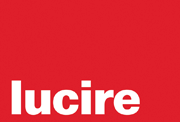If you were to describe Chile in five words or
fewer, ‘a force of nature’ could sum things up. The mainland of the
ribbon-shaped nation is literally a country for all seasons, from
the deserts of the north, to the pulsating central coastal metropolises
of Santiago and Valparaiso, into the wine country and down south
to the verdant alpine expanses of Chile’s “lake district”. At the
very tip, the Chilean side of southern Patagonia is a rising star
in destination travel, where ends-of-the-earth scenery meets luxury
eco-tourism and adventure vacations.
Cities
on the hill
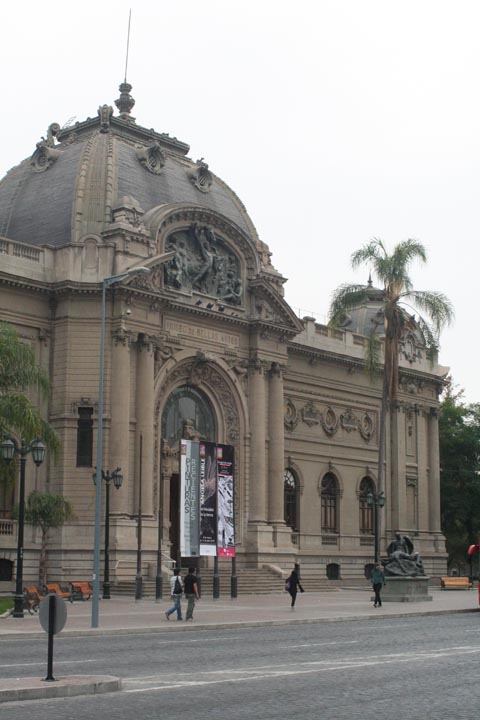
The home of Pablo Neruda (the iconic poet formally
known as politician Neftalí Ricardo Reyes Basoalto) is one of Santiago’s
most visited attractions. However, other writers have left their
mark on Santiago while bringing a Chilean voice to international
literature. They include Angel Cruchaga Santa Maria, novelist Isabel
Allende and playwright Ariel Dorfman (known for his internationally
acclaimed play, La muerte y la doncella [Death and the Maiden]).
The most efficient way to
get acquainted with Santiago’s cultural, literary and culinary landscape
during daytime hours is to sign on for bike and walking tours. Architect–guide
Andreas Garrido of Paseos en Bicicleta does a brilliant job of immersing new arrivals by steering them
through trendy neighbourhoods such as Barrio Lastarria and past important
museums and landmarks, such as Museo Bellas Artes, Plaza de Armas
and Parque Forestal.
Many of the buildings in areas like Lastarria
unforgettably splice splashy paint jobs with an eclectic mix of architectural
styles stretching the decades and many world cultures (French and
German as well as Spanish). However, what really brings this Santiago
primer to life is Garrido’s discourse. His advice to visitors is
to dive into the city with no preconceptions in order to discover
it and fall in love with it. The same goes when it comes to getting
to know how Santiago’s denizens differ from those in other Latin
American cities.
‘You may think we are shy or depressed at first,
but actually, we are shaped by geography, as well as earthquakes,
floods and politics,’ Garrido remarks. ‘We are not Buenos Aires
or Rio. We are not outspoken, yet we are expressive as you will
see as we go through the parks and different barrios. Even with
the dramatic changes for the better we have experienced in the last
25 years with our (more liberal) economy, politics and culture,
the city continues to evolve. One hundred years ago, we wanted to be French.
In the 1980s, we wanted to be American, and now we want to be Chilean.
The city’s become an exceptional destination because we’ve learned
how to appreciate our intelligence, heritage and culture.’
continued below
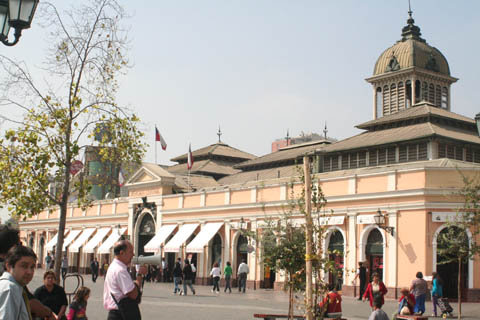
Upon arrival at the Mercado Central area, visitors
can shift gears with a walking tour led by American-born Colin Bennett
of FoodyChile. Though the Mercado Central itself
is cheerfully commercial and worth a walk-through, Bennett spirits
his charges into the heart of La Vega, a consortium of four working
markets. Though they are vibrantly gritty, the produce areas impress
with neatly organized stalls overflowing with oversized vegetables
and carnival barker-like meat and cheese vendors.
While grand hotels
and upscale chains like the W are well represented in Santiago,
its boutique properties and restaurants set the mood for a stay
uniting romantic elements of the European-influenced old world with
modern-day splash. Le Rêve, in the Providencia
neighbourhood, does it by paying tribute to Santiago’s French cultural
roots. The rooms and public areas have a deliciously Parisian
feel, and there are some surprising amenities like an open, home-y
kitchen offering guests a midnight snack.
Fashionistas who prefer
to live on the edge, and are definitively in the market for local
Chilean labels, will find two malls around the corner from le Rêve
just may fulfil their dreams of some unique finds. Though the Drugstore
Mall’s interior design defies gravity, every corner of the three-dimensional
maze yields great discoveries including the city’s best ice cream
and some interesting one-off boutiques, from Mo’s streamlined basics
and fashion-forward things at Las Urbinas 23 to the frilly-girly
wares at O! and Pituqui-Pinaqui. Up the block, Casa & Ideas (which
reads to the eye as the lovechild of US retailers Crate & Barrel
and Anthropologie) stocks cheerful housewares and practical gift
items. continued below
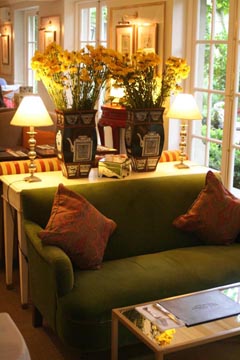 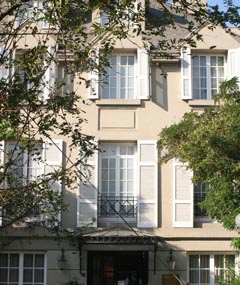
Anybody who has been to Asia, meanwhile, will
find nearby Vivo Panorámico’s eclectic layout and random mix of
high- and low-end stores similar to malls in Tokyo and Bangkok. However,
most of the shops’ fashion sensibility leans Latin American.
Amid
all the sparkle and flash, there is the matter-of-fact leather shop
Osorio Opazo, offering a mix of frankly comfortable work and walking
shoes, beautifully crafted cowboy boots, timeless fashion boots
and a few unexpectedly fashion forward styles thrown in for good
measure. Discreetly hidden in middle of trendy Bellavista, the Aubrey
(a sublime private residence-turned-urban retreat),
is so decadently homely and inviting, and its food and cocktails
so inventive that it could stand as the perfect amalgam of all of
Santiago’s worthwhile neighbourhoods.
However, you will have to get
your self outside its protective gates into the night. The neighbourhood
is a hub for some of the city’s innovative, upscale restaurants
and clubs. While those cafes specializing in “modern Chilean” cuisine
are plentiful, Borago, in the über-chic and exclusive
Vitacura neighbourhood, pushes that notion and locally procured ingredients
to extremes, and with great showmanship. Though takes effort (a
cab ride or car rental), a trip to ritzy Barrio Las Condes neighbourhood
lends another perspective on how modern Chileans live tastefully.
On an inauspicious residential street, former
LAN Chile Airlines executive chef Maria Eugenia Terragno Merino
opens her home to visitors, bringing forth an ultimate local dining
experience. At her Terragno Cocina (terragno-cocina @ @ vtr.net),
adventurous diners can book an intimate dinner or learn to cook
a meal and make a perfect pisco sour in her eclectic, expansive
kitchen. After lunch, one can stroll Las Condes’ high-end shopping
streets, scout Chilean designer finds at the city’s best indoor
malls such as Alto Las Condes, or take a stylish detour to the Museo
de la Moda and its changing parade of themed
exhibits.
At press time, the space was winning raves for
its celebration of all things 1980s, as it did before that with
focuses on Madonna, Michael Jackson, Princess Diana and other fashion
eras. vtr.net),
adventurous diners can book an intimate dinner or learn to cook
a meal and make a perfect pisco sour in her eclectic, expansive
kitchen. After lunch, one can stroll Las Condes’ high-end shopping
streets, scout Chilean designer finds at the city’s best indoor
malls such as Alto Las Condes, or take a stylish detour to the Museo
de la Moda and its changing parade of themed
exhibits.
At press time, the space was winning raves for
its celebration of all things 1980s, as it did before that with
focuses on Madonna, Michael Jackson, Princess Diana and other fashion
eras.
Valparaiso, about 75 miles northwest of Santiago, bears many
similarities to other Pacific port cities such as Wellington,
San Francisco and Vancouver. Besides an expansive bay, this UNESCO
World Heritage City has a strong college town vibe, an artist colony
flavour and lots of festively painted dwelling lining its steep hills.
In contrast to Santiago (which for many is about hitting noteworthy
neighbourhoods and ticking museums and landmarks off the list), Valparaiso
is a city better suited for going where the day takes you. continued below
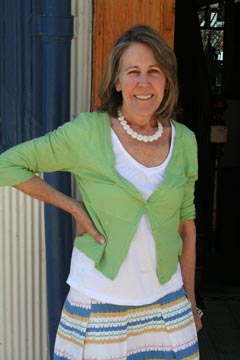 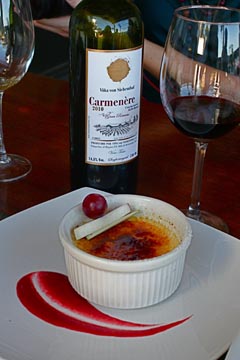
Judith and Gerrity von Daam, the American couple
behind the widely acclaimed restaurant La Concepcion,
started their own life experience in Valparaiso that way. What they
built from it is a location with great views from practically every
table as well as perfect ceviche, inspired Chilean–Mediterranean
seafood main courses and lovely desserts with Chile’s famously ripe
fruit. When you walk off a late lunch at this fantastic restaurant,
you will inevitably make pit stops at the numerous art galleries
and one-off boutiques selling lapis, hand-crafted clothing and home
accessories.
Just outside Valparaiso, a stop at Casa Marin
is a must for enophiles. Maria-Luz Marin is inspiring, both as a
pioneering Chilean woman winemaker and a major force within Chile’s
international wine boom. While Marin at one point helped develop
and produce wines for the mass market, she is now determined—no
matter how big Chile's wine industry gets—to ensure wines evolving
from her vineyards will stand out on their own. While her winery
and tasting room are exceptionally pretty and exhibit a woman’s
touch (adorned with elaborate inlays and mosaics created by her
sister, Patricia), Casa Marin is also noteworthy because of its
daring location just two and a half miles from the Pacific Ocean.
Marin certainly knows her stuff, having gone
straight from college to winemaking in the mid-1970s, even though
women winemakers at that turbulent time in Chile’s history were almost
unheard of. While she relishes the fact she was the first female
winemaker to work for a private winery, and later found success
making wine for multiple US and UK clients in the mid-1990s,
she had the nagging feeling there was more that she could do to
be a true winemaker as opposed to being a wine producer. While she
had the clout to open a winery bearing her name, she did not want
to take the path of least resistance, knowing that route would result
in wine with little soul or character.
continued 1 | 2 | 3 |
 |
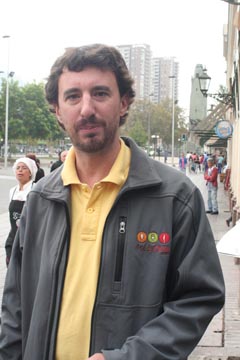
FoodyChile’s Colin Bennett
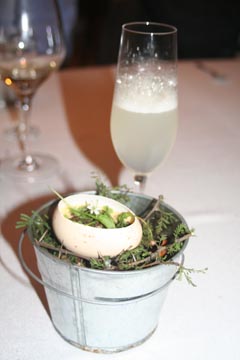
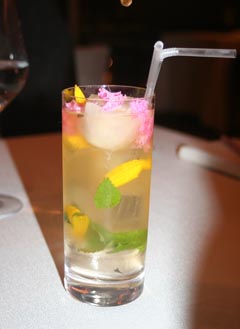
Drinks at Borago
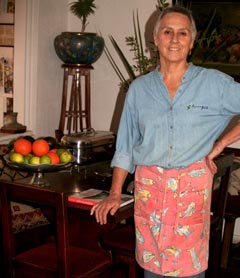
Former LAN Chile Airlines executive chef Maria Eugenia Terragno Merino of Terragno Cocina
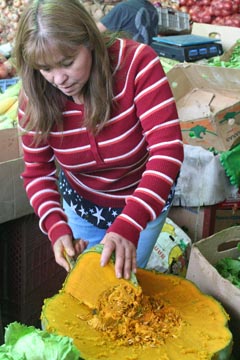
An enormous squash
Valparaiso, about 75 miles northwest of Santiago, bears many similarities to other Pacific port cities such as Wellington, San Francisco and Vancouver. Besides an expansive bay, this UNESCO World Heritage City has a strong college town vibe, an artist colony flavour and lots of festively painted dwelling lining its steep hills
|
